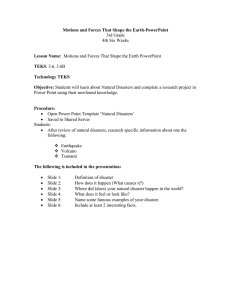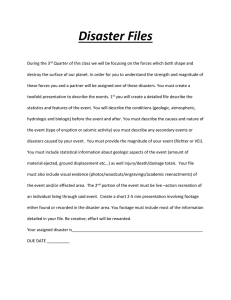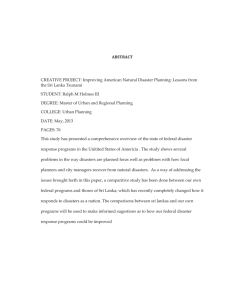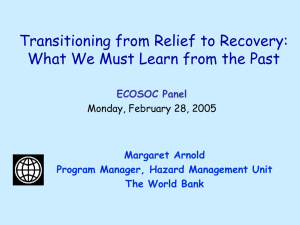C , D & D
advertisement
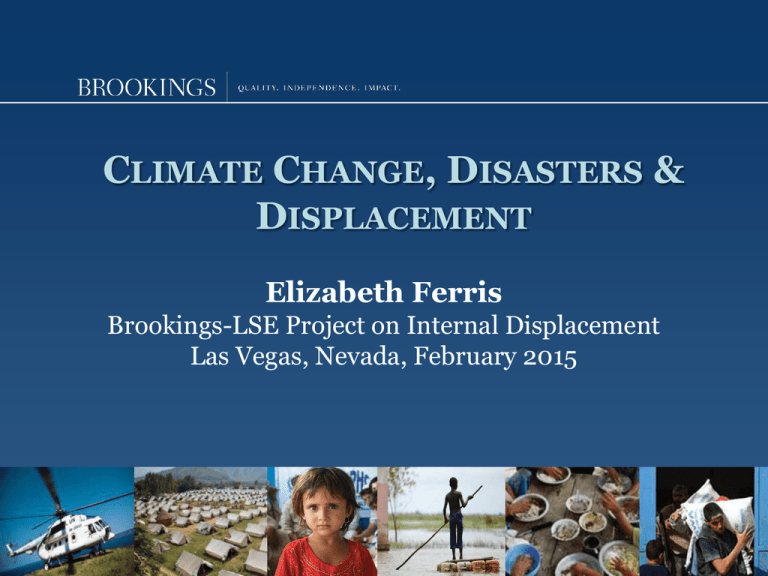
CLIMATE CHANGE, DISASTERS & DISPLACEMENT Elizabeth Ferris Brookings-LSE Project on Internal Displacement Las Vegas, Nevada, February 2015 1 Climate change will make certain parts of the world uninhabitable. >Warming temperatures >Sea level rise >More intense & unpredictable weather events 2 Tuvalu , Jane McAdam, USW 3 4 Somalia/AP photo/Rebecca Blackwell 5 6 Climate change & human settlement patterns • Coastal settlements: half of US population lives within 50 miles of coast • An urbanized world, a more populous world • Land degradation 7 Coastal Cities Miami Manila 8 Mobility as Adaptation Framework Convention on Climate Change (Cancun, 2010) “14, Invites all Parties to enhance action on adaptation under the Cancun Adaptive Framework… by undertaking, inter alia, the following: >> (f) Measures to enhance understanding, coordination and cooperation with regard to climate change induced displacement, migration and planned relocation, where appropriate, at the national, regional and international levels;” 9 Climate Change & Mobility • Migration • Displacement • Planned Relocation 10 Migration as Adaptation • Voluntary, often anticipatory • Often those with means • Both internal and cross-border • Kiribati’s ‘Migration with Dignity’ approach • Those crossing borders are likely to use existing migratory channels 11 Displacement • Forced, usually after disaster or loss of livelihoods • Affects both rich and poor • Mostly within a country (internally displaced persons, IDPs) some cross-border (legally NOT refugees, nor economic migrants) 12 Planned relocations • When governments move people to protect them, before or after disaster, e.g. ‘no-build zones’ • When communities want to relocate but need support • Probably affects mostly those without the means to move on their own • Already occurring under the radar screen • Mixed outcomes Hurricane Ivan, Photo: Nasa 14 Natural hazards & disasters A hazard: A dangerous phenomenon, substance, human activity or condition that may cause loss of life, injury or other health impacts, property damage, loss of livelihoods and services, social and economic disruption, or environmental damage (UNISDR, 2007) A disaster: A natural disaster is defined as “the consequences of events triggered by natural hazards that overwhelm local response capacity and seriously affect the social and economic development of a region.” (IASC) 15 But: How natural is natural? Haiti’s deforestation & risk of hurricanes Haiti: 16 Example: Wildfires • Natural or human-caused? • Only disaster where humans can intervene • In US, decrease in number (from 100K to 50K from 1960-2012) but increase in acreage (4 million to 10 million) and houses destroyed (200 to 2872) • Wildfires & climate change 17 Hazards Slow-onset Rapid-onset Drought Cyclones, Typhoons, Hurricanes Desertification Storm surge Sea level rise Flash flooding Erosion Earthquakes Water salination Volcanic eruptions UK Climate Change & Migration Coalition, “Understanding a slow disaster: getting to grips with slow-onset disasters, and what they mean for migration and displacement” 18 Trends in sudden-onset disasters • Good news! Fewer fatalities • Bad news: more people affected, more displaced, higher economic costs • Hydrometeorological: 87% of disasters, 74% of losses, 61% of fatalities, World Bank 2014 • Recurring, cascading disasters 19 Not all affected equally… • The poor, often living on marginal land and in poorlyconstructed housing, are disproportionately affected by disasters • Those who are less physically mobile—young children, the elderly and those with physical disabilities—find it difficult to evacuate • Death rates for women tend to be much higher than for men when flooding or tsunamis occur • Relief efforts can discriminate against vulnerable or marginalized groups 20 21 And then there’s climate change: “A changing climate leads to changes in the frequency, intensity, spatial extent, duration, and timing of weather and climate extremes, and can result in unprecedented extremes” (IPCC) 22 Infographic: The Union of Concerned Scientists, based on information from the IPCC 23 A few examples of climate change & mobility: The Carterets, Alaska, the Philippines 24 Carteret Islands Business Insider 25 Futuretimeline.net .6 km² land, 6 small islands, 2,700 inhabitants 26 • Impacts of climate change: rising sea levels, coastal erosion • Since, 1994, almost 50% of Carteret Islands’ surface lost to rising sea level • Decision to relocate to mainland, but 10 years of efforts have been unsuccessful • Obstacles: finding a host community, acquiring the land, creating new livelihoods 27 Alaska ADN 28 • Alaska has warmed twice as fast as the global average in the last fifty years • Melting of permafrost and temperature increases lead to erosion and flooding • Melting of sea ice coupled with fiercer storms increases coastal erosion • Erosion control, flood protection – but also since 2003 efforts to relocate indigenous communities • Climate change impacts on other Arctic people – Norway, Greenland 29 Typhoon Haiyan 2013 Boston.com 30 • Haiyan: Equivalent of Category 5, the highest — and the strongest tropical cyclone to ever make landfall • 4500 dead, 13 million affected — 13% of the country's population-- 4 million displaced, large-scale economic losses • But “no famine, no disease outbreaks, and no secondary major displacements.” (UNHCR) » Recovery plan developed a year after Haiyan, » Plans underway to relocate 1 million people » Protracted displacement, complicated land tenure 31 Lessons? • Prepare for new shifting ‘normal’ • Recognize that disaster risk reduction works and costs money • Redouble efforts to mitigate climate change • Get ready for increasing numbers of people on the move 32 Thank you!
